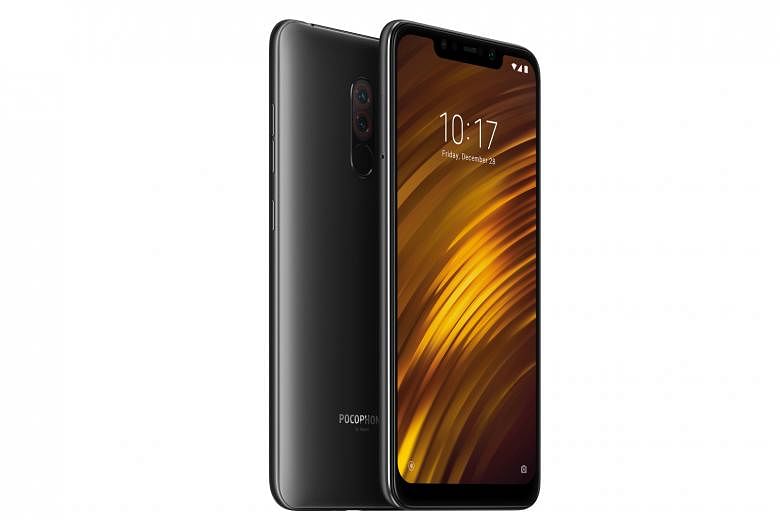Xiaomi's latest Pocophone F1 generated much buzz among smartphone enthusiasts earlier this month after its official reveal in India.
The reason: It offers top-class performance that rivals flagship models, but at a significantly lower price.
In Singapore, it costs $449, putting it in the mid-range segment.
But inside the Pocophone is the same Qualcomm Snapdragon 845 chip used by Samsung in its Galaxy S9 and Note9 smartphones in markets like the United States.
Until the Pocophone's arrival, the most affordable smartphone equipped with the Snapdragon 845 chip was the OnePlus 6, which costs about $800.
Complementing this processor is 6GB of memory, as well as 64GB of internal storage that uses the Universal File Storage standard (found in top phones), which is faster than the older eMMC format found in most budget and mid-range models.
As a result, the Pocophone feels as responsive as the OnePlus 6. Both produced identical scores in the Geekbench 4 benchmark test (about 9,000 for the multi-core segment).
-

SPECS
RICE: $449
PROCESSOR: Qualcomm Snapdragon 845 (Quad-core 2.8GHz, quad-core 1.7GHz)
DISPLAY: 6.18-inch, IPS LCD, 2,246 x 1,080 pixels, 403 ppi pixel density
OPERATING SYSTEM: MIUI 9.6 (Android 8.1)
MEMORY: 64GB (microSD expandable to 256GB), 6GB RAM
REAR CAMERA: 12MP (f/1.9) and 5MP (f/2.0)
FRONT CAMERA: 20MP (f/2.0)
BATTERY: Non-removable 4,000mAh
-
RATING
FEATURES: 4/5
DESIGN: 4/5
PERFORMANCE: 5/5
VALUE FOR MONEY: 5/5
BATTERY LIFE: 5/5
OVERALL: 4/5
To ensure that the Pocophone runs at its maximum speed for as long as possible, it has a built-in heat-pipe to better cool the processor. Samsung's latest Note9 smartphone boasts a similar heatpipe for this purpose.
This cooling solution seems to work because the phone felt only slightly warm on the outside after a 30-minute gaming session with popular online shooter game PUBG Mobile. It runs the game like a charm, without any stuttering or lag.
The Pocophone is affordable because it lacks certain bells and whistles found in premium models.
It is not waterproof and does not have wireless charging or NFC (Near-Field Communication).
The display is a standard LCD screen instead of a more expensive Oled version - like the one on the OnePlus 6.
I do not mind some of these trade-offs. For instance, the slippery and fragile glass back used in most high-end phones is gone. In its place is a more reassuring, matt-plastic back.
It is not as sleek or as light as some phones, partly because of its 4,000mAh battery.
It explains the outstanding battery stamina - I was surprised to see the battery gauge showing 75 per cent at the end of the day. I could even afford to charge it once every two days instead of daily.
Charging the phone is speedy, thanks to its support for Qualcomm's Quick Charge technology.
Another feature that I was glad to find is the 3.5mm audio jack, which has been omitted from many flagship phones, except for Samsung models.
In addition to the standard fingerprint sensor at the back, the Pocophone has an infrared facial scanner that promptly recognises my face and unlocks the phone.
I hardly got to see the lockscreen when testing this phone because it unlocked almost instantly to show the Home screen.
The facial-recognition feature also works in the dark, though it failed to recognise me when I was not wearing my glasses or when my eyes were closed.
Its dual rear cameras exhibit almost no shutter lag, though there is a one-second delay for its artificial intelligence (AI) to identify the scene correctly. Xiaomi says the scene-recognition feature can identify 25 types of objects, ranging from text to buildings.
This AI-powered approach may not necessarily produce better photos than professional photographers, but it is handy for casual users, especially when sometimes, all that is needed is a simple tweak, like brightening an image, which can be automated.
Overall, the cameras produce sharp and good-looking photos, especially in the day.
The lack of optical image stabilisation hurts its low-light performance as I ended up with some blurry shots due to my less-than-steady hand.
Its Portrait mode, which blurs the background while keeping a human subject in focus, is more dramatic than subtle. But in some of my shots, there were some minor flaws at the edges of the subject.
For those who dislike Xiaomi's MIUI interface for its lack of an app drawer, the Pocophone runs a tweaked version of MIUI that adds this functionality, as well as a search bar, which shows up when you swipe up the Home screen.
But I do not like how notifications are handled because I often miss them.
While notifications do show up on the lock screen when they first arrive, they subsequently disappear.
They also do not appear in the notification bar at the top of the screen like most Android devices.
The only sign of new notifications is the white LED indicator at the bottom of the phone, but it is tiny and easy to overlook.
• Verdict: Capable of matching flagship models stride for stride while having excellent battery life. Unbeatable value for money.


